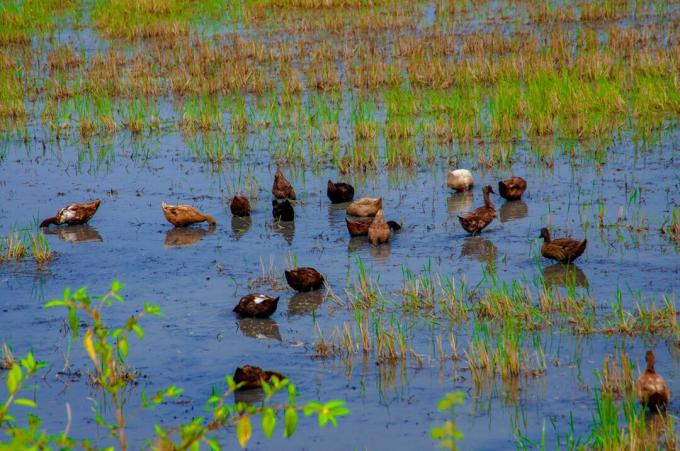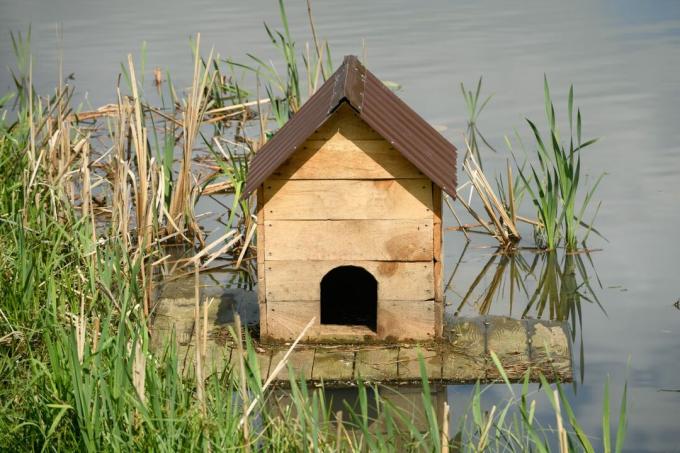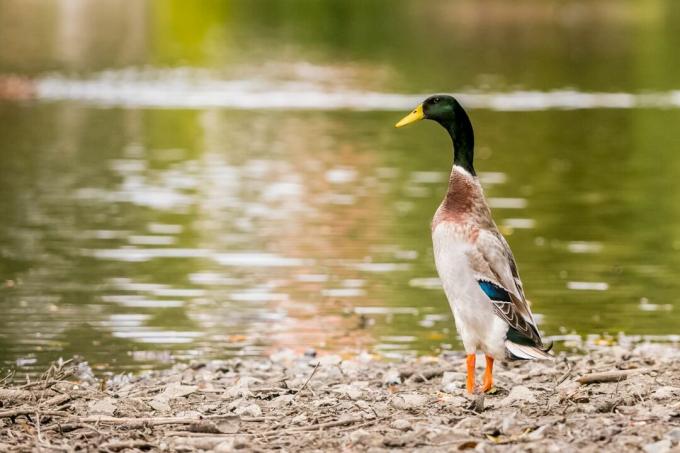Running ducks are becoming more and more popular. They even eat the Spanish slug, which has hardly any natural enemies here.

Snails, primarily slugs, are a ubiquitous nuisance in almost every garden. Especially the immigrated Spanish slugs (Arion vulgaris) love to lay hands on everything that grows in the garden. There the running duck creates (Anas platyrhynchus f. domestica) definitely a fix. But the whole thing is not that easy, because runner ducks also have their needs. The animals need care and enough space. If you take this into account, running ducks can be an asset to your garden.
contents
- Ducks versus snails
-
This must be taken into account when keeping running ducks
- The perfect enclosure for running ducks
- Feeding ducks properly
- Sufficient space for running ducks
- Advantages and disadvantages of running ducks
-
Do running ducks help against snails and co?
- Ducks versus snails
- Runner ducks against the box tree moth
Ducks versus snails
Runner ducks come from Asia, which also explains the frequent designation as Indian runner ducks. There the animals were made from common wild mallards (Anas platyrhynchus) bred. The similarities are obvious. The animals are often adorned with the same plumage as mallards wear. But there are also other colored runner ducks, such as black or white-piebald. In contrast to their wild relatives, the animals can hardly fly, but they can run quite fast. They were originally kept for their excellent eggs, but they are now making a name for themselves as snail fighters. And who knows, maybe a troop of ducks will soon move into your garden to fight the slugs?

This must be taken into account when keeping running ducks
The keeping of ducks and chickens does not differ significantly. It is not for nothing that both species are often kept together. However, as waterfowl, ducks bring a lot of moisture into the coop, which is not particularly good for chickens. Separate stables are therefore appropriate. This problem does not occur when kept together with other waterfowl. If you also keep geese, for example, you should ensure that both groups of animals are given separate shelters in the barn due to the physical inferiority of the ducks. Ducks of different breeds can be kept in the same area without hesitation.
Naturally, the top priority continues to be species-appropriate husbandry – this primarily means plenty of space and sufficient food. Be aware that the animals depend on you and you are responsible for their welfare.

The perfect enclosure for running ducks
On the one hand, running ducks need a stable that protects them at night from predators such as foxes and martens and in winter from severe minus temperatures. This should offer at least half a square meter of space per duck. A larger area is recommended, particularly in view of the cold season, when the ducks often spend half the day in the barn. It should also be kept in mind that the ducks may breed and suddenly there are two groups of ducks that need enough space. A larger barn also gets dirty less quickly and offers space to store cleaning equipment or other material. In any case, always pay attention to the local building regulations for new buildings. A very large barn may require approval.
Characteristics of an optimal duck house:
- Stable floor structure
- Window with protective grille on a quiet side
- Entrance gate about 40 by 30 cm in size and at ground level or with a non-slip ramp
- Wood litter as bedding and a layer of straw on top
- Possibly water dispenser
- Heavy bowl or feeding trough, preferably with a feeding fence to prevent jealousy

Access to a bathing facility is also essential. Like all ducks, runner ducks enjoy a dip in the refreshing water. A creek offers ideal conditions for keeping ducks, because the flowing water washes away faeces and other impurities. To prevent ducks from swimming away, a fence should be erected above the water level to allow fish below to pass.
Admittedly, hardly anyone has such an influx on their property. So the next best thing is a pond. Here, too, the runner ducks can groom their plumage, look for food or soak it. Since their droppings cannot drain off here, a sewage treatment plant is needed for a large pond. In addition, a liner pond should be covered to protect the liner from the sharp claws of the animals. A drain is recommended for changing the water. This is a practical solution, especially in summer, when the water sometimes has to be cleaned weekly. Alternatively, pumping is also possible. The water - enriched with nutrients from the duck droppings - can be used for watering.
tip: Walking ducks dig in the ground in search of food. The reinforcement of the shore, for example with coarse gravel, counteracts this.

As a temporary solution, tubs filled with water can be provided for the ducks to bathe and drink in. If the containers are large enough, they can also be used permanently as a substitute for natural water bodies. Here, for example, an old bathtub or a paddling pool could help. In models with a high pool edge, a non-slip ramp makes it easier for the ducks to get in and out. Inflatable pools need to be patched or replaced from time to time and are therefore not a sustainable solution.
Tip: The smaller the bathing facility, the more frequently it needs to be cleaned.

Feeding ducks properly
Even if the ducks have enough space to search for and find plants such as duckweed or dandelions, If you have insects, snails, worms, spawn and tadpoles, you should always give them some food as well offer. This should contain different cereal grains. A grain mix is best for waterfowl. This usually consists of wheat and also usually contains corn, barley, soybean meal and oats as well as vitamins and minerals.
As a mineral, lime is of vital importance. The animals have to consume this in order to produce the shell of the eggs. If there is a lack of lime, the shell is thinner and, in extreme cases, the egg even remains shellless. In addition, ducks eat small stones, which they need for their digestion. You can use poultry grit for this, which also contains lime.
Keep in mind that ducks also like to eat young vegetables. So the vegetable garden must be protected from them. If the ducks are allowed to go into the bed after the harvest and digging, they are a great help against slugs!

tip: Duck feed should have a minimum crude protein content of 15 percent.
Don't skimp on food, especially if there aren't that many other food sources available at the moment. By the way, ducks are also excellent leftovers. They eat food that is hardly seasoned or salted with devotion. However, you should never feed them avocados. You should also be sparing with nitrate-containing foods such as chard or spinach. Because nitrate can be converted into toxic nitrite. Rice, pasta and bread are eaten with pleasure, but are usually not particularly nutritious. To prevent digestive problems, fruit should only be fed in small amounts. Raw nightshade plants, such as uncooked potatoes, should not be fed as they have a high solanine content. Dairy products are only suitable as feed to a limited extent. A small amount in leftovers is tolerated, but not too much.
tip: Weeds removed from the garden can also be fed to ducks.
There is no question that there should be more than enough clean water for the animals to drink. The running ducks need this to be able to swallow slugs. If there is too little or none at all, ducks can suffocate painfully on snails! Therefore, never place slugs you have collected in a bowl in front of the ducks' beaks! Likewise, the water is used to soak food. To prevent a big mess in the water bowl, you can offer the ducks soaked feed directly. Make sure that pre-soaked feed is refreshed daily and the bowls cleaned so it doesn't become spoiled and eaten by the ducks and cause disease.

Sufficient space for running ducks
In principle, a fence with a height of 80 centimeters is sufficient as a fence, because ducks do not like to fly. However, the stitches should be tight, as the animals with their slender bodies can fit through surprisingly small holes. And if the fence is not anchored to the ground, this is also a welcome opportunity. The ducks need enough space inside the fence all year round. Ducks want to run, so 500 square meters is not too much for a pair of ducks. Under no circumstances should it be less than 100 square meters per duck.
But runner ducks do not only have material needs. They are social animals, so they need at least one partner to explore and chatter with. You can keep runner ducks, for example, as a pair or as a larger flock. In the case of a larger herd, it is advisable to have more females than males as the females will then be less bothered at mating season.
tip: Do not forget the legal conditions when purchasing the running ducks. The animals must be reported to the veterinary office.
What should you consider when keeping running ducks?
- Stable as protection from predators and sub-zero temperatures
- bathing opportunity
- Always enough fresh drinking water
- At least 100 m² space per duck
- Always provide extra food
- Safe fence
- society for the animals

Advantages and disadvantages of running ducks
Ducks are wonderful animals. With their unsteady gait on their big feet, they look extremely bizarre. Not only are they quite interesting to watch, they bring even more life to the garden. In most cases they are kept to fight snails. But they also bring numerous other benefits. For example, these are the tasty duck eggs, which the chattering fellows produce in large numbers - after all, up to 160 eggs per year and duck. This is particularly worthwhile for people with chicken protein allergies, because they can often eat duck eggs without being bothered – but you should have them tested for possible cross-allergies beforehand. In addition to being useful as egg suppliers and snail eaters, runner ducks also make charming pets. With a lot of love, some runner ducks can become so tame that they can be picked up with enthusiasm.

Of course, with all the enthusiasm for running ducks, one should not forget that the animals also have their requirements and are not only there to please people. The problem with the animals is that they are so intelligent: almost everywhere there is a hole in the fence, you will find it. If there are tasty salads or freshly planted young plants behind this hole, then soon there will be nothing left. In addition, the ducks must be adequately protected from predators. So you should make sure that the animals go into the barn at night. On cold winter days with lots of snow, hungry predators sometimes venture into the gardens with chickens and ducks even during the day.
Do running ducks help against snails and co?
The question of whether running ducks help against slugs and other pests can definitely be answered with yes. They even like to eat the annoying pests. But one shouldn't hide the fact that running ducks are also quite popular as a nice change eat up a head of lettuce or, to the annoyance of the grower, new plantings and seedlings ruffle What is not eaten as a small plant is nevertheless exposed to the large duck feet that mercilessly trample over everything. The motto "ducks in the garden and everything is in the best order" does not quite apply.
It is therefore advisable to fence off a sufficiently large area in the garden - as a base camp, so to speak. Here are the stable, the feeding place and the bathing opportunity. Between late summer and spring, when the lettuce has already been harvested and there is not much left in the garden, the ducks are then given free rein until spring. During the summer months you can then offer the animals space on a meadow. Another variant is to let the animals into beds that have already been harvested with a mobile fence or to fence off beds that have not yet been harvested. The runner ducks are not in the bed during the main growing season, but they can catch snails on their way to the lettuce.

Ducks versus snails
Even if the ducks are not allowed into the bed to protect the vegetables, they protect them from snails. This works particularly well if the bed is rather tidy and superficially dry during the day due to early morning watering. Because then snails prefer to hide outside the vegetable patch during the day and can be tracked down there by the running ducks. When the bed is cleared in autumn and the snails lay their eggs, you should definitely let the ducks into the bed. In this way, the runner ducks reduce their offspring for the coming year. Next summer there will be far fewer snails in the garden.
If you would like to let your ducks into the beds in the summer, then you should keep the animals away, at least when the vegetable and ornamental plants are still very young. Later, you can carefully experiment with which plants will leave your ducks untouched.
Ducks in the garden: an alternative
Is the effort for running ducks in the garden too high for you? No problem! As an effective alternative, we suggest slug pellets, which can also be used in overgrown beds. Our Plantura organic slug pellets Consists of iron-III-phosphate, which protects beneficial organisms and is more rainproof than other grains. You can find out what needs to be considered when using it in our article on the subject. Incidentally, our slug pellets are also harmless for running ducks. Note, however, that slug pellets with other active ingredients can be very dangerous for your feathered helpers.
Runner ducks against the box tree moth
But running ducks not only help against snails. They also love to eat the larvae or caterpillars of box tree moths. No wonder, because the two animal species have certainly met more often in their homeland in Asia. The boxwood (boxysempervirens) leave them untouched – an excellent combination. Boxwood contains toxins. Because the borer caterpillars are stuffed with boxwood leaves before they are caught by the runner ducks themselves be eaten, care should be taken to ensure that the runner ducks do not ingest too many of the caterpillars permit.

Do running ducks help against snails and co?
- Runner ducks effectively remove snails all year round and their eggs in autumn
- Lettuce and young vegetables like to end up in the ducks’ stomachs – along with the snails
- To use walking ducks effectively, you should plan when the ducks are allowed to go where
- Runner ducks also help against the caterpillars of the box tree moth, because they are poisonous, but they should not eat too many of them
If you are looking for more methods to Fighting snails If you are interested, you can find our article on the subject here.



